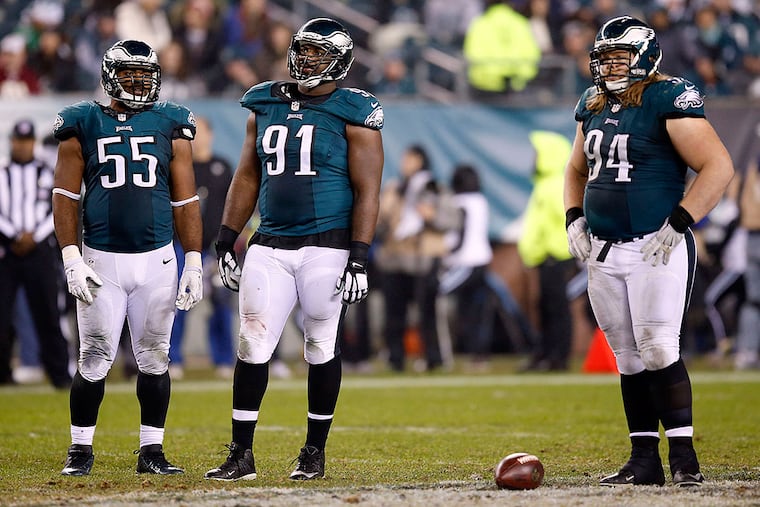Can current Eagles fit into a new defense?
Three years ago, the Eagles made a radical change to their defense. They shifted from a 4-3, "wide-nine" defensive front to a 3-4. The next coaching change could bring a similar philosophical shift.

Three years ago, the Eagles made a radical change to their defense. They shifted from a 4-3, "wide-nine" defensive front to a 3-4. The next coaching change could bring a similar philosophical shift.
The new coach will determine the defensive scheme, but it's something the players must think about entering the offseason. Many of the players on the Eagles defense were brought in by Chip Kelly's staff to play in this scheme.
"I think for everybody, it should matter," safety Malcolm Jenkins said. "Not everybody fits in every scheme. . . . Whenever you get a new philosophy, it changes a little bit. You have to refigure out where you're going to be, what your role is. So, it'll be interesting to see how that plays out."
Jenkins has played in a 4-3 and in a 3-4, and he said as a defensive back, he prefers the 3-4 because it allows the safeties to focus more on the passing game. He noted that some of his most productive seasons have been in a 3-4 defense.
It helps that many of the Eagles veterans have played in both. Lineman Fletcher Cox started his career in a 4-3, with Juan Castillo as the defensive coordinator and Jim Washburn as defensive line coach. Linebackers Connor Barwin and DeMeco Ryans played in 4-3 and 3-4 defenses in Houston. Although it has less of an effect on the secondary, cornerback Byron Maxwell came to the Eagles from a 4-3 scheme in Seattle.
"Each one has its perks," Ryans said. "Three-four, you're able to zone-pressure a little bit more without showing your hand. Four-three, you're able to get the guys up front going a little more as far as pass rush. They're able to attack more."
Half of the NFL ran 3-4 defenses this season, and the other half ran the 4-3. Considering the proliferation of passing offenses and three- and four- receiver sets, defenses employ extra defensive backs nearly as often as they use their base formations. But the base defense is important because that directs the types of players teams target.
The Eagles played a two-gap defense in which the defensive linemen were responsible for gaps on both sides of the offensive linemen. They looked for players who fit that skill set, and reserves such as Taylor Hart were targeted specifically for that defense.
The outside linebackers needed to be able to rush the passer, set the edge on running plays, and also drop into coverage. The skill sets are different in a 4-3.
When the Eagles selected Cox in the first round of the 2012 draft, he was believed to be an ideal fit as a penetrating defensive tackle in a 4-3 scheme. Cox had 51/2 sacks as a rookie in that defense. It took him time to adjust to the Eagles defense when it switched to a two-gapping, 3-4 alignment. He emerged as a force last season - his second year in the scheme - and became a Pro Bowler this year with 91/2 sacks.
"The unique thing about it is I've played both - 4-3 attacking style and the 3-4 - and I'm looking forward to whatever the new coach is bringing in," Cox said. ". . . The more challenging thing is I've been playing in coach [Bill] Davis' [system] for three years now. You've got to learn a whole new scheme, a whole new playbook. It might be the same type of stuff but different terminology."
Players such as Cox, Brandon Graham, Vinny Curry, and Mychal Kendricks were inherited by the coaching staff. But Kelly also brought in players specifically for the scheme.
When the Eagles signed Barwin before Kelly's first season, he was the only natural 3-4 outside linebacker the team had on the roster. He came from a 3-4 scheme in Houston and had a body type (6-foot-4, 264 pounds) that the Eagles liked at the position. But Barwin said that he is not exclusively a 3-4 outside linebacker and that he could also fit in the 4-3 - the defense he first played with the Texans.
"I'll be fine. I'd love to play a 4-3 D-end," Barwin said. "I've always said there's not as much a difference [between] outside linebacker and D-end as people try to make it. A 4-3 would be great."
The Eagles drafted Bennie Logan in 2013 to play nose tackle, which is one of the most demanding positions in a 3-4 defense, because that player lines up over the center. But Logan pointed out that he was a 4-3 defensive tackle at Louisiana State who never played in the 3-4 until coming to the Eagles.
In fact, the Eagles would seem to have personnel who could play in either scheme. Graham spoke about his interest in again playing in the 4-3 before he re-signed with the Eagles last March. Curry is a better fit in the 4-3 than a 3-4, and that will likely factor into his decision on the free-agent market this offseason.
Kendricks, Jordan Hicks, and Kiko Alonso can all play linebacker in the 4-3. The Bills even planned on moving Alonso to outside linebacker last season before he tore his anterior cruciate ligament, and Kendricks started as an outside linebacker as a rookie.
It's all conjecture until the Eagles hire a coach and know their defensive direction. But this personnel would be better-equipped to make a switch this season than it was three years ago.
"We'll see who they hire and what that coach wants to bring in as far as philosophy, scheme, personnel," Jenkins said. "It's really unknown at this point."
@ZBerm